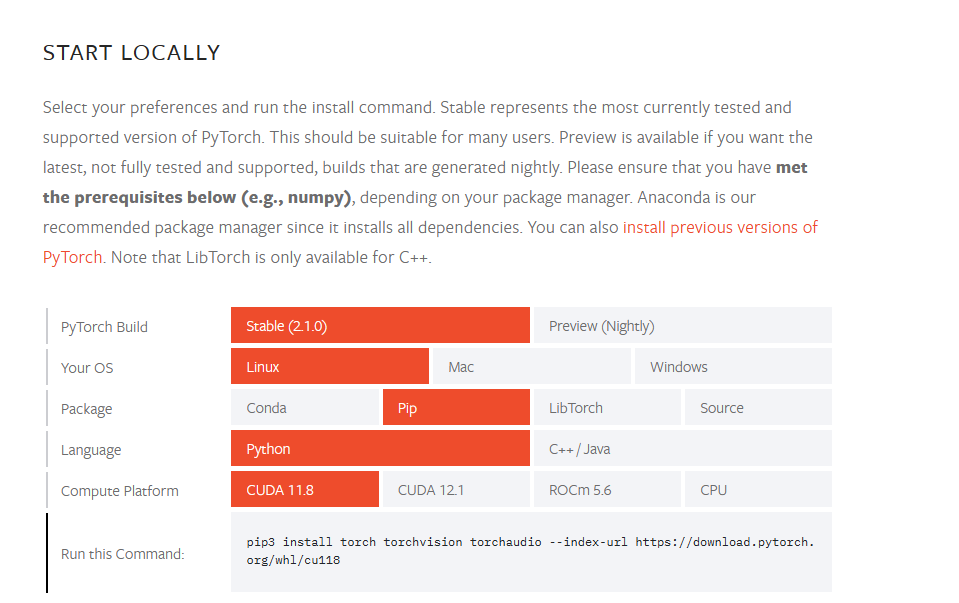CUDA
CUDA (Compute Unified Device Architecture) is a parallel computing platform and application programming interface (API) model created by NVIDIA. It allows software developers to use a CUDA-enabled graphics processing unit (GPU) for general-purpose processing.
Before installing CUDA
Before installing CUDA, you need to make sure you have a compatible GPU. You can check the list of CUDA-enabled GPUs here: https://developer.nvidia.com/cuda-gpus.
Try running nvidia-smi to see if you have a compatible GPU.
nvidia-smi
Install CUDA
To install CUDA, download it here: https://developer.nvidia.com/cuda-toolkit-archive.
Don't forget, you also need to decide which version of CUDA to install. Not all CUDA supports all driviers!
First you need know the verison of the driver via nvidia-smi. And query the doc to know which CUDA it supports:
https://docs.nvidia.com/cuda/cuda-toolkit-release-notes/index.html
Run:
echo "Installing CUDA... Do NOT select the driver!!!"
sudo sh ./cuda_11.8.0_520.61.05_linux.run
PATH="$PATH:/usr/local/cuda/bin"
echo "PATH=\"$PATH\"" | sudo tee /etc/environment > /dev/null
source /etc/environment
nvcc --version
That would install CUDA 11.8.0 on your system.
Install Nvidia Container Toolkit
If you are using Docker, you may need to install Nvidia Container Toolkit.
Please refer to document here to install Docker and Nvidia Container Toolkit if you need CUDA in Docker.
Install cuDNN
To install cuDNN, download it here: https://developer.nvidia.com/rdp/cudnn-download.
Run:
echo "Installing CUDNN..."
sudo apt-get install ./cudnn-local-repo-ubuntu2204-8.9.0.131_1.0-1_amd64_cuda11.deb -y
sudo cp /var/cudnn-local-repo-*/cudnn-local-*-keyring.gpg /usr/share/keyrings/
sudo apt-get update
sudo apt-get install libcudnn8=8.9.0.131-1+cuda11.8
sudo apt-get install libcudnn8-dev=8.9.0.131-1+cuda11.8
sudo apt-get install libfreeimage-dev
Install PyTorch
DO NOT directly type pip install torch!!! The torch you installed may not be compatible with your CUDA and you may see error:
AssertionError: Torch not compiled with CUDA enabled
First open here: PyTorch
And finish this tutorial:

You may see a command:
pip3 install torch torchvision torchaudio --index-url https://download.pytorch.org/whl/cu118
That should be the correct command to run.
How to tell if the driver is installed?
Run:
nvidia-smi
To get more details, like if it is licensed, run:
nvidia-smi -q
How to tell if CUDA is installed?
Run:
/usr/local/cuda/bin/nvcc --version
To test the CUDA, create a hello-world.cu:
#include <stdio.h>
__global__ void helloCUDA()
{
printf("Hello CUDA from thread %d in block %d!\n", threadIdx.x, blockIdx.x);
}
int main()
{
// 4 blocks, 8 threads per block
int numBlocks = 4;
int threadsPerBlock = 8;
// launch kernel
helloCUDA<<<numBlocks, threadsPerBlock>>>();
// wait for device to finish
cudaDeviceSynchronize();
return 0;
}
Now run it!
nvcc ./hello-world.cu -o hello-world && ./hello-world
How to tell if cuDNN is installed?
Run:
cat /usr/include/cudnn_version.h | grep CUDNN_M
To test it, run:
cp -r /usr/src/cudnn_samples_v8/ /tmp
cd /tmp/cudnn_samples_v8/mnistCUDNN
make clean && make
./mnistCUDNN
If cuDNN is properly installed and running on your Linux system, you will see a message similar to the following:
Test passed!
How to tell if torch is installed?
Run python, and type:
import torch
print(torch.cuda.is_available())